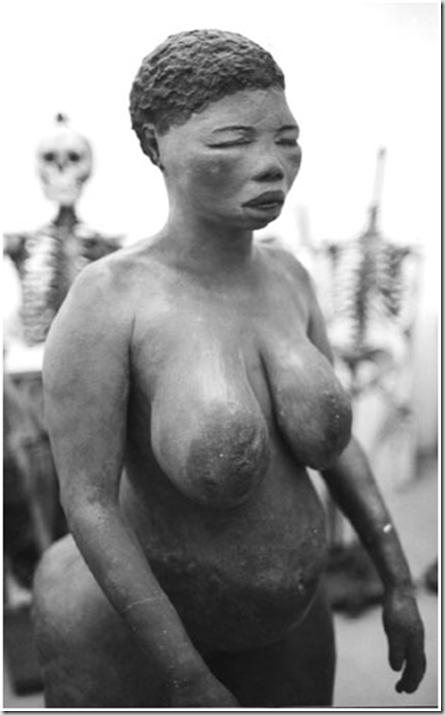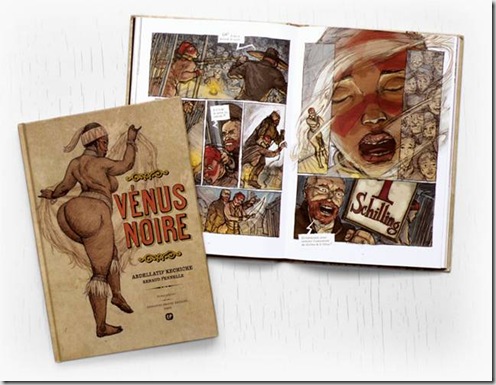 Dedicato alla stessa storia, il lungometraggio è stato presentato in settembre al Festival del cinema di Venezia. Interpretato dall’esordiente afro-cubana Yahima Torres, "Venus Noire" verrà distribuito in Italia da Lucky Red.
Dedicato alla stessa storia, il lungometraggio è stato presentato in settembre al Festival del cinema di Venezia. Interpretato dall’esordiente afro-cubana Yahima Torres, "Venus Noire" verrà distribuito in Italia da Lucky Red.http://renaud-pennelle.com
http://renaud.pennelle.blog.free.fr/
La storia e le immagini dell’epoca
Saartjie Baartman nacque nel 1789 in tribù Griqua dell’ Eastern Cape, un sottogruppo delle persone Khoisan che ora si pensa siano i primi abitanti aborigeni della punta meridionale dell'Africa. La famiglia si trasferì a una baracca vicino a Cape Town e, mentre lavorava come serva di 20 anni presso un agricoltore locale, attirò l'attenzione del chirurgo di una nave inglese , William Dunlop. Ciò che attirò la curiosità del medico erano la sua straordinaria steatopigia (posteriore prominente dovuto ad accumulo di grandi quantità di grasso nelle natiche) e le sue labbra vaginali insolitamente allungate, una peculiarità genitale di alcune donne Khoisan del tempo. Lei accettò di andare con Dunlop in Inghilterra dove, lui diceva, sarebbe diventata ricca e famosa come soggetto di ricerca medica e antropologica. Lei aveva 21 quando lasciò Cape Town per Londra.![clip_image001[8] clip_image001[8]](https://blogger.googleusercontent.com/img/b/R29vZ2xl/AVvXsEiJ5_z8QPKS25NtctJlgZjfZKYugunL9M1255xgAcJf7zVjkpZPDybvrRd5cPQQdeYiQ5AJ6mt6L-EfybgqZByQfpiqh8Ew9ez1VwS14T5dZrX1mGHdGduWLlH6HB2isg0ynMY-3HJVVh4n/?imgmax=800)
Saartjie “Sarah” Baartman 1789 – December 29, 1815
In un primo momento, fu messa sotto esame anatomico dagli scienziati, che chiamarono la sua condizione genitale 'il grembiule ottentotta'. 'Ottentotta' era una parola coniata dai primi coloni olandesi in Sud Africa per descrivere la strana lingua cliccando della Khoisan.
![clip_image001[6] clip_image001[6]](https://blogger.googleusercontent.com/img/b/R29vZ2xl/AVvXsEif976wlI8fPhTpcofrFFsWcD4j48IIkBrOYgeOQNKgbK22c7g6rzfg-S6ifPmMjMiUUYMjl038gqM7f-FDaF_LaOEmd934ZXLFzjEY8YJGn7kcp-ncIPbOO5LHrOpO0V6Rg9wYNu1jHC0/?imgmax=800)
A caricature of Baartman drawn in the early 19th century
![clip_image001[10] clip_image001[10]](https://blogger.googleusercontent.com/img/b/R29vZ2xl/AVvXsEj0_QkTGlYRr6rq2DA85qgcAdzgm72lF3oR_UtVazX797ix2uZcS9OiHN9LTpD2LJIJ1jWmrk5h9utr8NqDba4TGsNTwJHI6ya05Nb0Dpi3MA7K2skIdciapy0Ui5DuZjKJh3a2SVox0eEX/?imgmax=800)
A contemporary image of Sarah Baartman describes her as 'now exhibiting in London' . Courtesy of Westminster Archives
![clip_image002[8] clip_image002[8]](https://blogger.googleusercontent.com/img/b/R29vZ2xl/AVvXsEgU8leysWYj6Cw2B3t8CZrudOb9evEtZoUajS5zCWkZWlPseDFIkc40JA9jUF_a3tN-N4XPtMWDJLL8Fm4OCHaCmQ9Kokjav3QvmuIRy2zFf43m6NXClUNya33VqKOEqQfGYeOXWlGYcJ1w/?imgmax=800)
Sarah Baartman als Hottentot Venus; an den Stuhl gelehnt, das von ihr gespielte Instrument, eine
Ma l'unico successo che raggiunse fu come fenomeno da baraccone. Il suo guardiano domatore la mostrava al pubblico in una gabbia da cui la tirava fuori come fosse una selvaggia, suscitando un’esitazione eccitante. È la Venere ottentotta. Portata a Parigi nel 1814, la donna veniva presentata in feste aristocratiche più o meno licenziose.

L’eco dello spettacolo arrivò ai naturalisti dell’Università che pagarono i suoi padroni per studiarne il corpo e misurarne ogni dettaglio, soprattutto le grandi natiche e la particolarissima estensione delle piccole labbra della vulva.

Quando la donna rifiutava di mostrarsi completamente nuda agli scienziati veniva picchiata dai suoi sfruttatori.

La degradazione subita la condusse in un bordello e poi per le strade, sino a che sifilide e tubercolosi non la uccisero nel 1815. Questa la vicenda di Saartjie Baartman. Il corpo venne venduto dopo la morte agli stessi naturalisti che non erano riusciti a studiarla in vita come pretendevano.

Al Musee de l'Homme un calco dell’intera persona a grandezza naturale, gli organi genitali e il cervello conservati nella formalina costituirono oggetto di lezione di anatomia razziale da parte di insigni studiosi, tra i quali Georges Cuvier. Costoro affermarono con sicurezza che la conformazione del cranio, del volto e del sedere di questa “femmina” la avvicinava assai più all’orango tango che all’Homo sapiens sapiens. Soltanto nel 2002 i resti e lo scheletro di Saartjie vennero restituiti al Sudafrica e trovarono finalmente sepoltura nell’Eastern Cape, dove era nata.

Saartjie Baartman's skeletal remains being prepared for transportation
![clip_image001[4] clip_image001[4]](https://blogger.googleusercontent.com/img/b/R29vZ2xl/AVvXsEjA-Fu4rM4xUH0RFa7lpkxdDTgtQGfjUg6XdNC6u1SwulfIG-zwhj3onEba5OUslGSzcZSvGnKQtP2Ll1_LTc-rMO0cP3btV2AO2DTj4YrB-rU5wLEZfunxbGaYXxCw8ts5SYOLScuIjpaS/?imgmax=800)
Khoisan children at Saartjie's arrival at Cape Town airport
"I've come to take you home -
home, remember the veld?
the lush green grass beneath the big oak trees
the air is cool there and the sun does not burn.
I have made your bed at the foot of the hill,
your blankets are covered in buchu and mint,
the proteas stand in yellow and white
and the water in the stream chuckle sing-songs
as it hobbles along over little stones.
I have come to wrench you away -
away from the poking eyes
of the man-made monster
who lives in the dark
with his clutches of imperialism
who dissects your body bit by bit
who likens your soul to that of Satan
and declares himself the ultimate god!
I have come to soothe your heavy heart
I offer my bosom to your weary soul
I will cover your face with the palms of my hands
I will run my lips over lines in your neck
I will feast my eyes on the beauty of you
and I will sing for you
for I have come to bring you peace.
I have come to take you home
where the ancient mountains shout your name.
I have made your bed at the foot of the hill,
your blankets are covered in buchu and mint,
the proteas stand in yellow and white -
I have come to take you home
where I will sing for you
for you have brought me peace."
home, remember the veld?
the lush green grass beneath the big oak trees
the air is cool there and the sun does not burn.
I have made your bed at the foot of the hill,
your blankets are covered in buchu and mint,
the proteas stand in yellow and white
and the water in the stream chuckle sing-songs
as it hobbles along over little stones.
I have come to wrench you away -
away from the poking eyes
of the man-made monster
who lives in the dark
with his clutches of imperialism
who dissects your body bit by bit
who likens your soul to that of Satan
and declares himself the ultimate god!
I have come to soothe your heavy heart
I offer my bosom to your weary soul
I will cover your face with the palms of my hands
I will run my lips over lines in your neck
I will feast my eyes on the beauty of you
and I will sing for you
for I have come to bring you peace.
I have come to take you home
where the ancient mountains shout your name.
I have made your bed at the foot of the hill,
your blankets are covered in buchu and mint,
the proteas stand in yellow and white -
I have come to take you home
where I will sing for you
for you have brought me peace."
Diana Ferrus, "A poem for Sarah Baartman"




Nessun commento:
Posta un commento